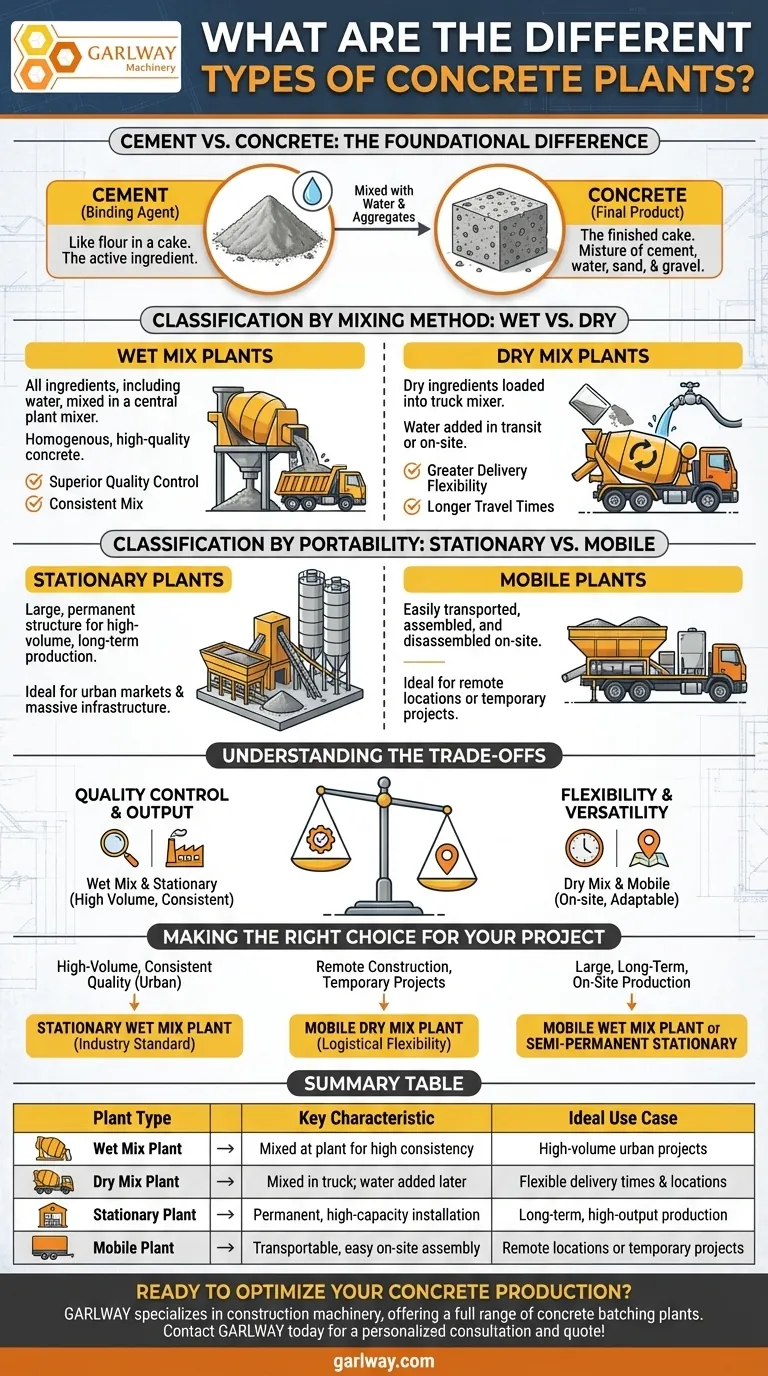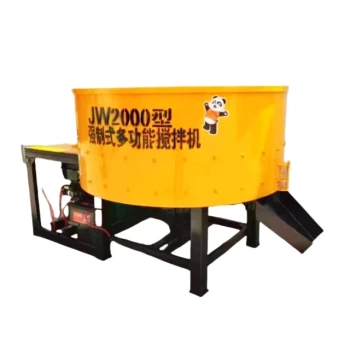First, a critical clarification: The terms "cement plant" and "concrete plant" are often confused, but they describe two very different operations. A cement plant manufactures cement powder from raw materials like limestone and clay. A concrete batching plant, which is likely what you're asking about, is where this cement is mixed with water, sand, and gravel to create ready-mix concrete.
The primary ways to classify concrete batching plants are by their mixing method (wet mix vs. dry mix) and their portability (stationary vs. mobile). This choice directly impacts the concrete's quality control, production volume, and suitability for a given project.

Cement vs. Concrete: The Foundational Difference
Before exploring plant types, it's essential to understand the materials themselves. This distinction is the bedrock of the entire industry.
Cement: The Binding Agent
Think of cement as the active ingredient, like flour in a cake. It's a fine powder that, when mixed with water, forms a paste that binds the other materials together.
Concrete: The Final Product
Concrete is the composite material, the finished cake. It's a mixture of cement, water, and aggregates (sand, gravel, crushed stone). The concrete plant's job is to combine these ingredients in precise ratios.
Classification by Mixing Method: Wet vs. Dry
The most significant technical difference between concrete plants is where the water is introduced. This determines the type of mixer used and the nature of the final product that leaves the plant.
Wet Mix Plants
In a wet mix plant, all ingredients, including water, are mixed together in a large, central mixer at the plant itself. The resulting product is homogenous, ready-to-pour concrete that is then discharged into a truck mixer for transport.
These plants are known for producing a very consistent and high-quality concrete mix due to the precise, controlled mixing process.
Dry Mix Plants
In a dry mix plant (also called a transit mix plant), all the dry ingredients (cement, sand, aggregates) are weighed and loaded into a truck mixer. Water is added to the truck either at the plant or upon arrival at the job site.
The mixing process happens inside the truck's rotating drum during transit. This method offers more flexibility for delivery times, as the concrete's hydration process doesn't begin until water is added.
Classification by Portability: Stationary vs. Mobile
The second major classification is based on the plant's intended location and duration of use.
Stationary Concrete Plants
A stationary plant is a large, permanent structure designed for high-volume, long-term production in a fixed location.
These are the workhorses for ready-mix companies that supply concrete to numerous projects within a metropolitan area or for massive infrastructure projects like dams and airports.
Mobile Concrete Plants
A mobile concrete plant is designed to be easily transported, assembled, and disassembled. This allows it to be moved from one project site to another.
They are ideal for temporary projects in remote locations or large construction sites that require a dedicated, on-site concrete supply for a specific duration.
Understanding the Trade-offs
Choosing a plant type involves balancing competing priorities. There is no single "best" type; the right choice depends entirely on the project's requirements.
Quality Control vs. Flexibility
Wet mix plants offer superior quality control and consistency because the entire batch is produced under controlled conditions in a single, efficient mixer.
Dry mix plants provide greater flexibility. Since water is added later, the travel time to the job site can be longer without the risk of the concrete setting prematurely in the truck.
High Output vs. On-Site Versatility
Stationary plants are built for maximum throughput and efficiency. Their large silos and high-capacity mixers can produce vast quantities of concrete continuously.
Mobile plants offer the unparalleled versatility of bringing production directly to the source. This reduces transportation logistics and costs for projects far from a central supplier.
Making the Right Choice for Your Project
Your decision should be guided by the primary goal of your operation or project.
- If your primary focus is high-volume, consistent quality for a major urban market: A stationary wet mix plant is the industry standard.
- If your primary focus is supplying remote construction or temporary projects: A mobile dry mix plant provides the most logistical flexibility.
- If your primary focus is a large, long-term project requiring dedicated on-site, high-quality production: A mobile wet mix plant or a semi-permanent stationary plant is the optimal solution.
Ultimately, understanding these classifications empowers you to select the precise technology needed to achieve your project's goals efficiently and effectively.
Summary Table:
| Plant Type | Key Characteristic | Ideal Use Case |
|---|---|---|
| Wet Mix Plant | All ingredients mixed at plant for high consistency. | High-volume urban projects requiring superior quality control. |
| Dry Mix Plant | Dry ingredients mixed in truck; water added later. | Projects needing flexibility in delivery times and locations. |
| Stationary Plant | Permanent, high-capacity installation. | Long-term, high-output production for a large market. |
| Mobile Plant | Transportable, easy to assemble on-site. | Remote locations or temporary projects requiring on-site production. |
Ready to optimize your concrete production?
Choosing the right plant is critical to your project's efficiency, cost, and quality. GARLWAY specializes in construction machinery, offering a full range of concrete batching plants—including mobile, stationary, wet mix, and dry mix solutions—for construction companies and contractors globally.
Let our experts help you select the perfect equipment to meet your specific needs. Contact GARLWAY today for a personalized consultation and quote!
Visual Guide

Related Products
- HZS180 Ready Mix Concrete Plant for Foundations with Sand and Cement
- HZS75 Concrete Batching Plant Cement Mixer Price Concrete Mixer Bunnings Mixing Plant
- HZS35 Small Cement Concrete Mixing Batch Plant
- HZS120 Ready Mix Concrete Batching Plant Commercial Mud Cement Mixer
- Portable Concrete Mixer Machine Equipment for Mixing Concrete
People Also Ask
- How to make ready mix concrete stronger? Boost Strength with Proven Mixing Techniques
- What are the disadvantages of ready mix concrete? Navigating Logistical and Cost Challenges
- How does ready-mix work? A Guide to Efficient, High-Quality Concrete Delivery
- How much does a batching plant cost? Uncover the True Investment for Your Project
- What are the advantages of a concrete plant? Achieve Consistent Quality & Efficiency for Large-Scale Projects















